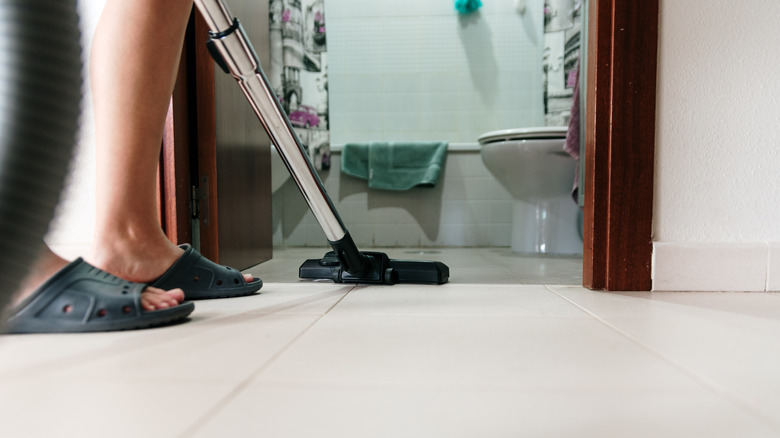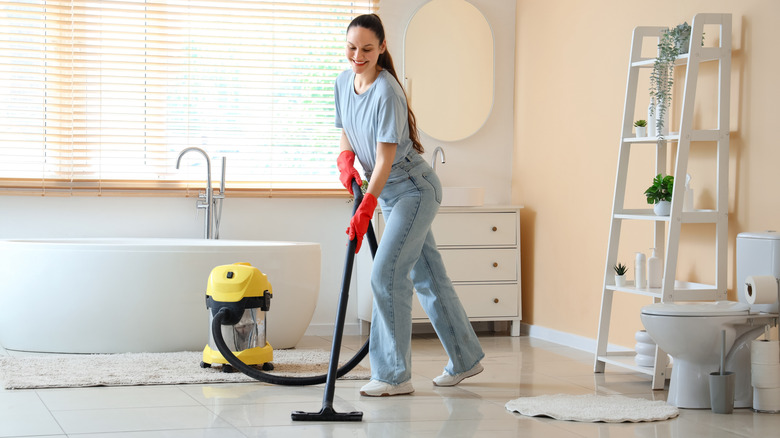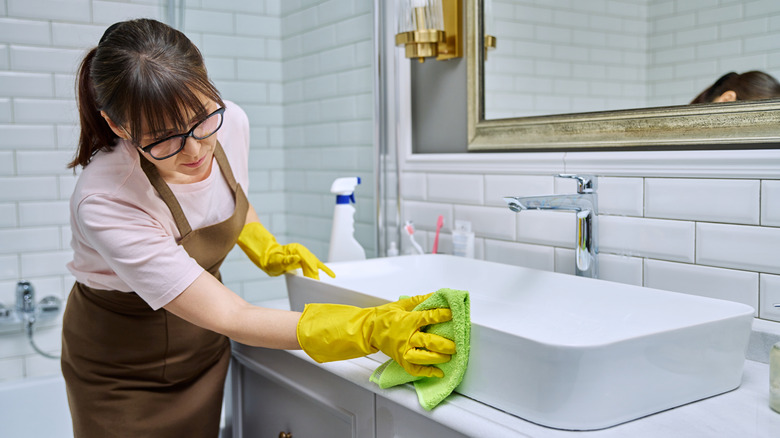Why A Vacuum Is Your Ultimate Hack For Cleaning Bathroom Floors
Some parts of your home can be managed with just a quick tidy-up, but those areas where cleanliness is super important really need to be thoroughly cleaned on a regular basis. In the bathroom, it's especially crucial to pay attention to the floor, which can quickly become covered in hair, dust, and other bits and pieces. That's where your vacuum comes into play. People often forgo this step since bathrooms generally aren't carpeted, thinking that a quick mop will do the job just fine. But here's the thing: When you mop over hair and dirt, all you end up doing is pushing the mess around, leaving streaks or clumps in your wake.
Vacuuming your bathroom first removes most of the debris quickly and efficiently, making the follow-up mopping and scrubbing more effective. This approach has the added benefit of leaving you with more energy to tackle the heavy-duty cleaning tasks — like cleaning your toilet the right way, scrubbing the shower, and making the sink shine.
Why vacuuming your bathroom is (almost) always a good idea
Vacuuming your bathroom floor before mopping is one of the easiest ways to make the entire cleaning process faster and more effective. Bathroom floors collect a surprising amount of loose dirt — hair, lint, dust, and so on — which can be tricky to sweep from between tiles and along edges. A vacuum can whisk all of this away in seconds, especially in tight spots around the toilet or under cabinets where it's harder to reach with a broom. Starting with a vacuum also saves time. When you skip this step and go straight to mopping, loose hair and grit often end up being pushed around the floor, leaving behind streaks or clumps. Removing the dry stuff first means your mop can focus on tackling stuck-on dirt and stains instead of getting tangled in hair.
Compact cordless vacuums make the job even easier, especially in small bathrooms where maneuverability is key. Just be sure to avoid vacuuming wet floors, as moisture can damage the motor, and always follow up by properly disinfecting them. Vacuuming removes debris, but it doesn't sanitize. The only time you might want to skip or delay vacuuming is when the floor is wet, sticky, or heavily soiled, in which case, mopping first can prevent clogs and protect your machine. Keep your vacuum clean and well-maintained to prevent odors and maintain suction power, and you'll find it quickly becomes one of your most useful tools for bathroom cleaning.
The best approach for maximum results
Start by removing everything from the floor: mats, bins, storage cabinets, the lot. You need the space to be clear to do a proper job of it. Make sure the surface is completely dry — as we know, vacuum motors and moisture don't mix. Use a narrow nozzle or crevice tool to target corners, grout lines, and the area around the base of the toilet – the part of the bathroom where everyone forgets to clean. Then, switch to a wider floor attachment to cover the main surface.
If your bathroom has ventilation fans or open shelving, dust these areas first so that any loose particles will fall to the floor, where the vacuum can collect them. Work methodically from the farthest point in the room toward the door to avoid stepping over freshly cleaned areas. Once all the dry debris is gone, follow with a mop and suitable floor cleaner to sanitize and remove any residue — remember, vacuums remove dirt, but they don't disinfect. Use a figure-eight motion for even coverage and fewer streaks. Then, let the floor dry fully before replacing everything you removed at the outset to prevent trapped moisture and mildew. By following this order — dust, vacuum, then mop — you'll get a cleaner finish in less time, without the frustration (and gag reflex) of chasing hair around with a mop.


